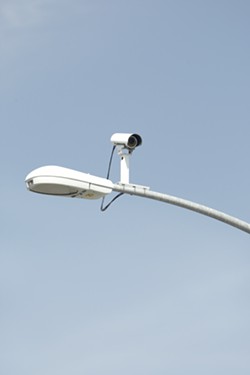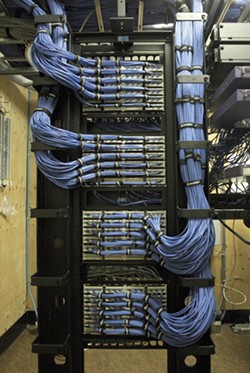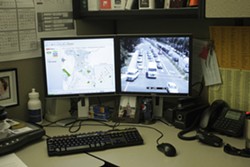[{
"name": "Ad - Medium Rectangle CC01 - 300x250",
"id": "AdMediumRectangleCC01300x250",
"class": "inlineCenter",
"insertPoint": "8",
"component": "2963441",
"requiredCountToDisplay": "12"
},{
"name": "Ad - Medium Rectangle LC01 - 300x250",
"id": "AdMediumRectangleCC01300x250",
"class": "inlineCenter",
"insertPoint": "18",
"component": "2963441",
"requiredCountToDisplay": "22"
},{
"name": "Ad - Medium Rectangle LC09 - 300x250",
"id": "AdMediumRectangleLC09300x250",
"class": "inlineCenter",
"insertPoint": "28",
"component": "3252660",
"requiredCountToDisplay": "32"
}]
On top of a city parking structure in downtown SLO there’s a small radio tower protected by chain-link fence and razor wire. It’s here that the video images from dozens of cameras perched on traffic signals across the city converge. They travel along the bundles of wires snaking down metal pipes, through five stories of concrete, and into a small control room where they spiderweb through a maze of cubicles in the city’s public works department.
Some of those wires lead to Jake Hudson’s desk.
Hudson, a tall and slender 29-year-old, is a senior traffic engineer for the city. On a recent day, he spun in his chair toward one of two flat-screen monitors in his small, but neatly ordered cubicle, and tapped a few keys on his keyboard.
Soon the screen lit up with video from the Madonna and Los Osos Valley intersection a few miles away. Four videos, all a full-color bird’s-eye view of every direction at the intersection, were squeezed together on the screen. Hudson expanded one of the images. Cars came and went. A group of Spandex-wearing bicyclists rolled up and stopped briefly before pedaling away. People walking down the sidewalk were visible.
At the time, Hudson only had video from the one intersection at his call. As of this printing, he planned to have a network of cameras from 33 other intersections—more than half of all the intersections in SLO—operational and capable of sending images to the desks of Hudson and two other traffic engineers.
It’s the largest assemblage of public cameras in SLO’s history, a vast network that feeds into a central computer system and allows for total visual access to every intersection equipped with a camera, all at the click of a mouse. The cameras are designed only for traffic monitoring and signal maintenance—and officials say that’s all they’re going to be used for, at least for now. But the road from traffic monitoring to surveillance isn’t exactly a rough commute.
The images aren’t recorded and there is no system to do so now, but there could be. Only a select few traffic engineers are allowed to view the images, but a bureaucratic switch could quickly provide others access. The cameras are used to help ease traffic congestion and not crowd control, but other cameras have been used for crowd control in the past, and the new cameras could easily serve that purpose.
Officially, in other words, this is not surveillance, despite what it might seem.
Before the cameras were networked, the only way to see the images was to physically go to the intersection, unlock a small green utility box on one of the corners, and flick on a small black Phillips TV. Then, last year, the city began a program to broadcast the video back to public works.
For a traffic guy like Hudson, they’re not video cameras, they’re a part of the city’s “traffic signal vehicle detection system.” The system detects when a car or cars approach an intersection and whether the light should be green or red. Traffic signals in SLO used to operate on a piece of wire under the concrete. Those wires, called inductive loops, are harder to maintain and can be damaged by road construction. So the city began shifting to video in 2000.
To the automated controller linked to each camera on site, the images are just pixels. A big patch of pixels means car, which means change the light. Hudson seems to share that perception. He sees a car on the screen, but what he’s looking for are tiny white lines framing that car so he knows the embedded controller also sees a car. The technology has improved since the late 1980s, but it can be tricked sometimes by dark shadows.
“The way that it’s all broken up, we can completely control the intersection,” he said.
There are 34 video-monitored intersections, many with four cameras each. Each camera hardwires its images to a small utility box where the video is processed, from which a signal is sent to switch the traffic light. But now, the same video is also sent to a small diamond-shaped antenna that broadcasts to public works.
It’s a lot like the system in the final scene in the movie The Italian Job, where Seth Green’s character hacks into the city’s traffic system and everything goes to hell. Hudson laughed at the comparison because it’s almost impossible to hack the system and cause that level of chaos. “I was like, ‘That’s bullshit,’” he said of the movie. It’s easy to tell Hudson is a total traffic-phile relishing in his new set of toys with no interest in the surveillance capabilities.
What if someone other than a hacker wants to watch? People from the SLO Police Department were interested in the new network, Hudson said. They lost interest because there is no built-in recording capability, he added. But local police didn’t need to record anything the last time they turned cameras on the public.
After the 2004 Mardi Gras riots, SLO police cracked down hard on potential partiers. In 2005 and again in 2006, the city “put a very extensive plan in place,” according to Chief of Police Deborah Linden. The plan included several “pole cameras” that were installed throughout the city for crowd control. Police monitored the cameras, Linden explained, and when it looked like a large group was forming, they sent an officer to go break it up. They were one-time “special operations” cameras, she added, and haven’t been used since. However, “… they were actually really effective.”
The answer to whether police or another organization could use the traffic cameras is a very firm maybe.
Linden and City Administrative Officer Ken Hampian said the cameras are absolutely not to be used for monitoring people. Bill Statler, director of finance and information technology, chimed in.
“Could this technology be used for that? Yeah.” He clarified, “I’m just saying they’re not designed for that purpose.”
One staff report on the traffic-camera system stated the cameras are for traffic purposes only. However, with a good enough excuse and a green light from the city manager, the entire system could go from traffic monitoring to surveillance. For the moment, at least, the surveillance light is red.
Surveillance society
Compared to large metropolitan cities, SLO has a relatively small number of cameras that monitor the public. But being on camera is becoming far more common here and almost incomprehensibly so in other parts of the country and the world.
“It’s just kind of really becoming so much a part of our culture,” Linden said.
According to the Electronic Privacy Information Center, based in Washington, D.C., even the nation’s capitol is growing large electronic eyes. In 2005, the center released an article stating that the District of Columbia police department had a network of 19 cameras on rooftops and buildings that all fed to a command center in police headquarters. Additionally, the mayor was proposing to place cameras in neighborhoods, parks, and commercial areas. In Chicago, according to the same article, there were 2,250 police-monitored cameras.
In 2006, the Surveillance Studies Network declared the UK the most surveilled country in the world. There are 4.2 million cameras hooked into the country’s Closed-Circuit Television (CCTV) system, according to the group’s report. That’s one camera for every 14 people, and the average Brit is photographed by 300 cameras every day.
Not including cameras on businesses and those operated by Caltrans, SLO has cameras at the police headquarters (13) that monitor mostly the interior holding areas but also the parking and front entrance, bathrooms in City Hall (one), Sinsheimer Swim Center (eight), and Laguna Lake Golf Course (two).
Hampian said he didn’t realize how many cameras there were until city officials wanted to use them to stop vandalism. In 2006, after repeated vandalism to the bathrooms in City Hall and at French Park, a group of city staffers met in a conference room and eventually the conversation turned to cameras.
He said the idea of installing cameras to monitor the public originally gave him the “heebie-jeebies.” Then his staff told him to just look around: Cameras are everywhere.
That year the city adopted a video-monitoring policy, which details what the cameras can be used for and the process necessary to install a new one.
“Our understanding is where there are cameras they tend to be effective,” Hampian said, “which is all the more reason to have a policy.”
The four-page policy says that in order to point a camera at a public building, there are three main criteria.
• It will deter theft or vandalism and potentially help catch a thief or vandal.
• It will help law enforcement investigate criminal activity.
• It will promote a safer environment.
In effect, the policy does not much limit where public cameras can go, so long as they’re aimed at public places and not pointed into private buildings or other places privacy is expected. Adding a new camera is more about making a case that it needs to be put up, rather than finding designated areas where one such camera is allowed under the policy.
New cameras go through a city review process. If a new one is placed, it’s supposed be accompanied by a sign so people know they’re on tape.
There’s a level of comfort in knowing there are rules to prevent a London-esque system of surveillance. But having a policy does not mean cameras won’t go up in SLO, nor does it mean the public will always know. For instance, the policy requires a sign near cameras so the public knows they might be under surveillance. Depending on the case, though, the city manager can override that requirement if it might “support crime prevention or investigative activities.”
There are no signs on the traffic cameras, for instance, because they’re not supposed to be used for surveillance, but it doesn’t mean they can’t be in the future.
City staffers and police don’t always have the same perspective. Take red-light cameras. City officials seriously considered installing such cameras at large intersections but shelved the idea.
Deputy Public Works Director Tim Bochum said it’s a dead issue; SLO just isn’t big enough to warrant the need for red-light cameras.
However, Lt. Steve Tolley said the cameras are still a possibility. He said SLO’s relatively small size was a factor in not installing the cameras, but the big roadblock is a legal one. In San Jose, for example, city officials decided to take down all the cameras because they didn’t work and in some cases actually caused more rear-end collisions from people trying to avoid a ticket.
Then there are other cases in Orange County and Arizona that have the potential to kill the use of red-light cameras altogether. Still, Tolley said if the issues could be resolved, they’d have their uses.
“If we could put them up, that’d be great,” he said, “because it could potentially reduce red-light collisions.”
You’re being watched, maybe
One of the central protections provided by the city’s video-monitoring policy is that the public is supposed to know when there’s a camera watching. Maybe, however, knowing there is a camera is worse than not knowing. In the late 1700s an English philosopher named Jeremy Bentham crafted what he believed to be the most effective prison design: the panopticon. It was designed so that multiple levels of prison cells wrapped in a circle around a central guard tower. The tower was designed so the guard could see out, but prisoners couldn’t see in.
Bentham believed the design would be incredibly effective because the prisoners would never know if they were being watched, only that someone might be watching. It might be so effective, he thought, that sometimes a guard wouldn’t even need to be in the tower for the prisoners to behave as if they were under surveillance.
Today, that theory is called the panopticon effect. Lillie Coney of the Electronic Privacy Information Center said it’s vital that governments inform people when they’re being monitored, but in doing so people naturally censor themselves.
“People living in these environments start to conform their behavior based on what they think is happening because they don’t know if someone’s watching or not,” she said, “but they know the possibility is there.”
Gail Lightfoot chairs the SLO County Libertarian Party. She said she has a general aversion to new technology, but especially the type that monitors people.
“We’ve become accustomed to someone looking over our shoulder and thinking nothing of it,” she said. “And then it’s turned against us.”
Tal Scriven, who chairs the Cal Poly Philosophy Department, agreed. He said people are regularly and proactively throwing away privacy through things like You Tube and “sexting” (that’s like sexy texting).
“No citizenry that routinely and happily dismisses its duty to keep its private lives private can expect the government to give serious weight to a right to privacy when even small gains in public safety are put on the other side of the scale,” he said in an e-mail.
So far, the largest network of cameras in SLO is resting in the uncomfortable realm of could-be-used-for-surveillance. Maybe it’s just that city officials don’t always see surveillance as particularly harmful or invasive. A New Times reporter thought it was a one-on-one conversation during a recent phone interview with Hampian. It was soon clear there were more unexpected people in the room. After a few minutes of silence, Linden’s voice buzzed over the speaker phone. Another surprise guest, Statler, spoke up minutes later to give his perspective on public surveillance. Ironically, one of the key points from all three was people should know when they’re being monitored. Who else was in that room listening but just didn’t speak up?
Staff writer Colin Rigley monitors his e-mail at [email protected].
Latest in News
Readers also liked…
-

Coast Unified teachers upset over new position's salary and qualifications
Oct 20, 2022 -

SLO police identify alleged driver who hit and killed couple
Dec 22, 2022 -

When the levee breaks: Oceano residents, county officials walk a tightrope of regulations to manage Arroyo Grande Creek, which some say led to the levee's failure in January
May 18, 2023











